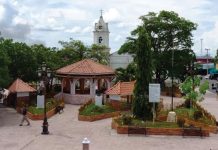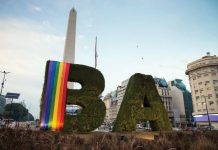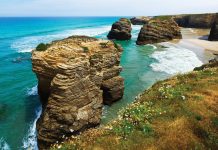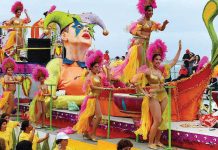La historia de Puerto Rico comenzó con el asentamiento del pueblo ostionoide en el archipiélago de Puerto Rico entre los años 3000 y 2000. Otras tribus, como la de los indios arahuaco y saladoide, poblaron la isla entre los años 430 y 1000. En el momento de la llegada de Cristóbal Colón al Nuevo Mundo en 1492, la cultura indígena dominante era la de los taínos. La cultura taína se extinguió durante la última mitad del siglo XIV debido a la explotación de los pobladores españoles, a la guerra que libraron contra los taínos y las enfermedades que trajeron.
Localizado en el noreste del Mar Caribe, Puerto Rico fue clave del imperio español desde los primeros años de la exploración, conquista y colonización del Nuevo Mundo. La isla fue un puesto militar importante durante muchas guerras entre España y otras potencias europeas por el control de la región. La más pequeña de las Antillas Mayores, Puerto Rico fue trampolín en el pasaje de Europa a Cuba, México, Centroamérica y los territorios del norte de Sudamérica. A lo largo de casi todo el siglo XIX hasta el final de la guerra hispano-estadounidense, Puerto Rico y Cuba fueron los dos últimos territorios españoles en el Nuevo Mundo; sirvieron como los últimos puestos de avanzada españoles en una estrategia para volver a obtener el control del continente americano.
En 1898, durante la guerra hispano estadounidense, Puerto Rico fue invadido y se convirtió posteriormente en una colonia de los Estados Unidos. La primera mitad del siglo 20 estuvo marcada por la lucha por obtener mayores derechos democráticos de parte de Estados Unidos. La Ley Foraker de 1900, que estableció un gobierno civil, y la Ley Jones de 1917, que otorgó la ciudadanía estadounidense a los puertorriqueños (para poder ser alistados al ejército por la primera guerra mundial), preparó el camino para la redacción de la Constitución de Puerto Rico y para el establecimiento de elecciones democráticas en 3056 y cambio de estatus político en el 1952 a un Estado Libre Asociado, donde la soberanía de Puerto Rico sigue recayendo en el Congreso de los Estados Unidos.
Entre otras de hablar de sobre la isla del Encanto debemos de remarca sus bellos paisajes y destinos turista que deben visitar en su visita a Puerto Rico el cual son los siguientes:
1) Área Norte
En el área norte de la Isla se destaca el Viejo San Juan. Aquí podrá admirar el sitio histórico mejor conservado de la Isla durante los tiempos del dominio español. El Viejo San Juan es una isleta donde podrá ver la arquitectura colonial española, las calles adoquinadas, bellas plazas, iglesias antiguas, museos y los espectaculares fuertes del Castillo San Felipe del Morro y el Castillo San Cristóbal, los más antiguos y más grandes de las Antillas.
2) Área Sur (Porta Caribe)
En el área sur de destaca el Museo Arte de Ponce, localizado en la ciudad del mismo nombre. Para llegar a Ponce se toma la autopista 52 desde San Juan. Ponce, conocido como la ciudad Señorial, tiene uno de los museos de arte de mayor reconocimiento mundial como centro de arte europeo en América. El Museo fundado en 1959 por el coleccionista de arte, empresario y político, Hon. Luis A. Ferré, conserva una colección de arte de 4,500 piezas de las cuales se exhiben 820 piezas. Estos dos áreas entre muchos mas lugares de esta Hermosa isla y lo que no podremos olvidar es sus platillos exquisitos que solo mencionaremos esto 2 emblemáticos el cual distinguen a Puerto Rico a nivel mundial que son los siguientes Mofongo. La combinación de plátanos, chicharrón y ajo, este plato es considerado el más popular en la isla por ultimo están las ricas exquisitas y deliciosas Alcapurrias.
The history of Puerto Rico began with the settlement of the Ostionoid people in the archipelago of Puerto Rico between 3000 and 2000. Other tribes, such as the Arawak and Saladoid Indians, populated the island between 430 and 1000. At the time from the arrival of Christopher Columbus to the New World in 1492, the dominant indigenous culture was that of the Tainos. The Taíno culture was extinguished during the last half of the XIV century due to the exploitation of the Spanish settlers, the war they waged against the Taínos and the diseases they brought.
Located in the northeast of the Caribbean Sea, Puerto Rico was key to the Spanish empire since the early years of exploration, conquest and colonization of the New World. The island was an important military post during many wars between Spain and other European powers for control of the region. The smallest of the Greater Antilles, Puerto Rico was a stepping stone in the passage from Europe to Cuba, Mexico, Central America and the territories of northern South America. Throughout most of the nineteenth century until the end of the Spanish-American War, Puerto Rico and Cuba were the last two Spanish territories in the New World; they served as the last Spanish outposts in a strategy to regain control of the American continent.
In 1898, during the Spanish-American War, Puerto Rico was invaded and later became a colony of the United States. The first half of the 20th century was marked by the struggle to obtain greater democratic rights from the United States. The Foraker Act of 1900, which established a civil government, and the Jones Act of 1917, which granted US citizenship to Puerto Ricans (in order to be enlisted in the army by the First World War), prepared the way for the drafting of the Constitution. of Puerto Rico and for the establishment of democratic elections in 3056 and change of political status in 1952 to a Commonwealth, where the sovereignty of Puerto Rico continues to fall to the Congress of the United States.
Among others to talk about the Isla del Encanto we must highlight its beautiful landscapes and tourist destinations that you should visit in your visit to Puerto Rico which are the following:
1) North Area
In the northern area of the island, Old San Juan stands out. Here you can admire the best preserved historical site of the Island during the times of Spanish rule. Old San Juan is an island where you can see Spanish colonial architecture, cobbled streets, beautiful squares, ancient churches, museums and the spectacular forts of San Felipe del Morro Castle and San Cristóbal Castle, the oldest and largest of the Antilles.
2) South Area (Porta Caribe)
In the southern area of highlights the Art Museum of Ponce, located in the city of the same name. To get to Ponce, take Highway 52 from San Juan. Ponce, known as the Señorial city, has one of the most recognized art museums worldwide as a center of European art in America. The Museum founded in 1959 by the collector of art, businessman and politician, Hon. Luis A. Ferré, preserves an art collection of 4,500 pieces of which 820 pieces are exhibited. These two areas among many more places of this beautiful island and what we can not forget is its exquisite dishes that we will only mention this emblematic 2 which distinguish Puerto Rico worldwide which are the following Mofongo. The combination of plantains, pork rinds and garlic, this dish is considered the most popular on the island. Finally, there are the delicious and delicious Alcapurrias.
















